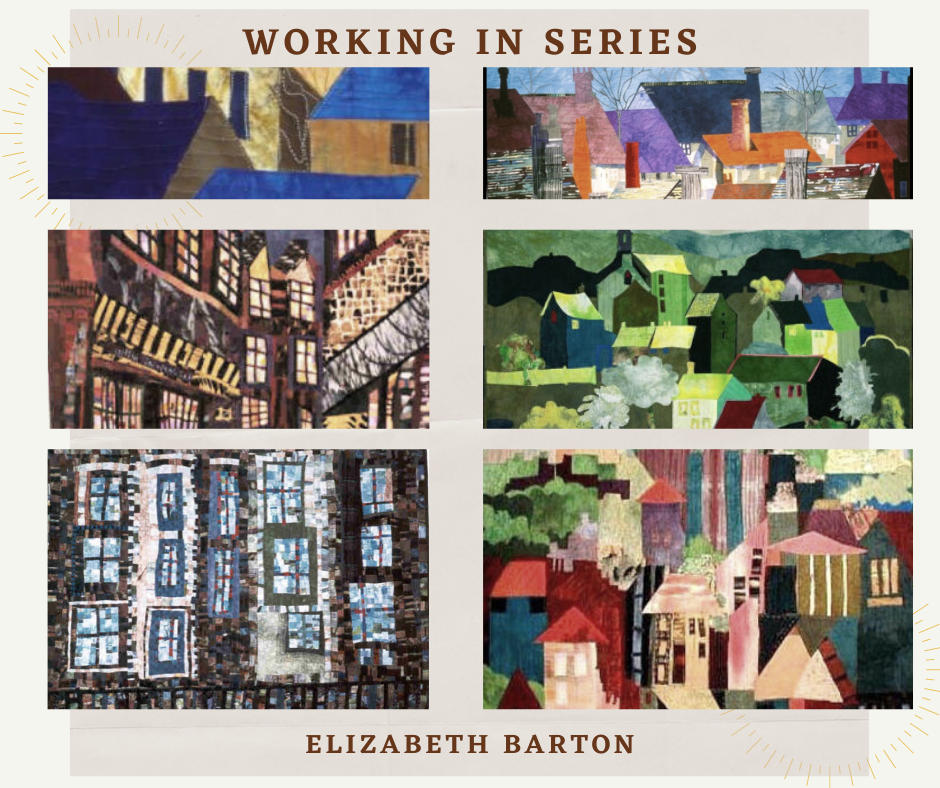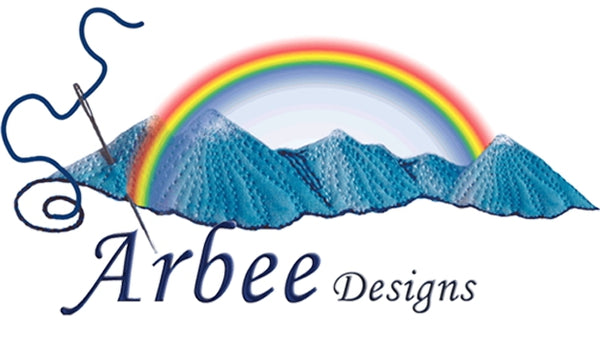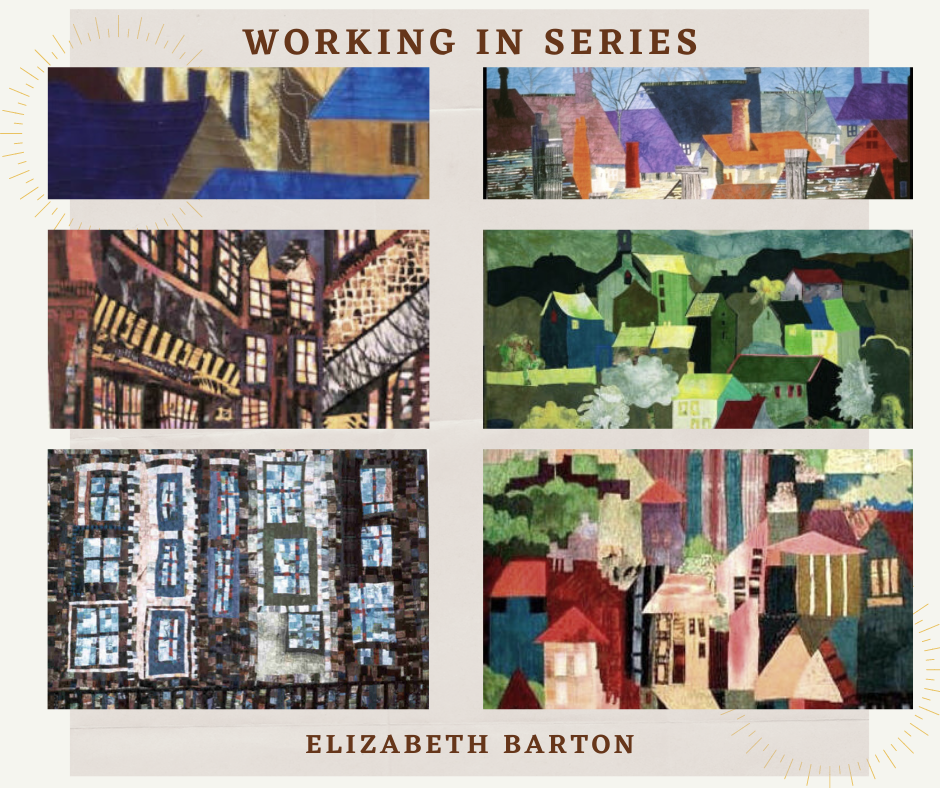
- Description
- Requirements
When you sign up for this on-demand class, you can choose from 10 or 14 weeks of dedicated time with Elizabeth. You can start as soon as you register or dedicate a date you wish to start. Be sure to let us know if you dedicate a date.
Do you want to improve your work as an art quilter? The best way to develop a coherent body of work is to work in a series. This workshop focuses on the development of at least 6 related designs for quilts. This can be accomplished either by working sequentially from one design to another or by planning six ideas at once.
Improve your skills and grow as an artist by focusing on a single idea or technique as you make a series of art quilts. Exercises in the first two lessons of this master class will help you clarify your ideas and choose a theme. By Lesson Three, you will be designing and working on your own series. The last two lessons provide examples of series work and delve into more detail on design and art tools. Award-winning quilt artist, Elizabeth will provide individual critiques and guide you through the design process.
Level: Intermediate to Advanced. You must be competent with basic art quilt construction and may use whatever methods you prefer. Class material covers composition and design.
Note: Once purchased, you can access the class data any time, 24 hours a day and you get immediate access. (if you don't have an account we suggest you sign up for one prior to purchase)
Time Duration applies only to teacher access for your question and answer duration.
Outline
Lesson One
- What it means to work in a series
- Why you should do it
- Inspirations
- Using past work to chart your course
- Motivation, practice and managing your time
- Ways of working in a series
- How to develop a series
- Choosing your theme
- How long a series should be
Lesson Two
- Developing parameters
- Deciding on techniques
- Tracing
- Sketching in pencil
- Sketching in watercolor
- Collage
- Photocopying
- Photographing
- Computer software
Lessons Three and Four
Both these lessons will have two parts
- Part A: In-depth critique of all images posted to the Gallery. You do not have to post if you are not ready BUT you should read the classroom discussions if possible because that is where the meat of the lesson will be found.
- Part B: Topics in composition as outlined below.
Lesson Three
- Achieving the illusion of depth
- Evaluating your designs
- Choosing strong color schemes and the use of simultaneous contrast
- Using rhythms and repetition to make a piece more interesting
- The use of value patterns (chiaroscuro or Notan)
- Landscape composition rules and how we can apply these ideas
- Pitfalls to avoid in working from photographs
Lesson Four
- Bringing energy and dynamism into your work
- Developing focal areas and emphasis
- Underlying structural patterns and balance
- Looking more closely at positive and negative space
- Visual pathways
- Shibui, the power of the mark of the hand
- Critiquing work of yourself and others
Supplies Required for Workshop
Inspiration Notebook: a notebook, binder, old shoe box, or folder on the computer. Into this inspiration notebook, put any pictures, paintings, photographs, doodles, or writings you find inspiring. This will be the well to which you return time and again when your imagination needs replenishment. The first thing to do when thinking about designing your own quilts is to start collecting inspirational images:
- your own, or other people’s photographs (you won’t be copying them, so no worries about copyright)
- sketches, drawings or doodles
- ideas such as "red balloons rising up into a blue sky", or "the Smoky Mountains: rolling hills in many layers with each layer greyer and softer than the one in front of it"
Fabric
This workshop is about developing a series of quilts. The fabric supplies are just suggestions and you will most likely have what you need at home. The non-fabric, non-sewing supplies will be used for the exercises in the first two lessons.
I hope you have a large stash, but do not run out and buy things before knowing what you need. For simplicity’s sake, I recommend that most of your stash be solid colored, or very low texture (soft nondescript designs) but the final choice will depend upon the subject you choose to focus on. It is important to have a good range of values, from very light to very dark in your favorite colors. If you have absolutely no idea what your favorite colors are, and definitely want to buy or dye something, I would recommend: white, black, and three grays: light, medium and dark. If you choose specific colors, always try to have a wide range of value, saturation and temperature.
- batting or flannel (sufficient for your quilt)
- fabric for quilt back
- basting thread or safety pins
Tools and other supplies
- rotary cutter, board, rotary ruler guides, spare blade – or scissors
- marking pencil (white charcoal or silver) for marking fabric for cutting
- freezer paper (if you prefer to make templates)
- sewing machine in good working order
- thread, needles, pins, scissors
- design wall or vertical boards on which to pin the work
- iron, ironing board
- plain paper for sketches and notes
- piles of old magazines to cut up for collage
- tracing paper
- ruler, pen, pencil
- a few colored pencils or felt pens. Light, medium, and dark grey pencils and a black felt tip pen are very helpful for value studies. A few watercolors or other paints, whatever you usually use for sketching
- an old picture mat (mount) you can cut in two or a piece of black paper, cardstock or poster board
- a camera (any kind)
- glue stick for collage
- computer with some simple photo/drawing graphic software: Photoshop Elements, Paint Shop Pro, GIMP (GNU Image Manipulation Program) - a free download comparable to the other two listed
- access to a photocopier

